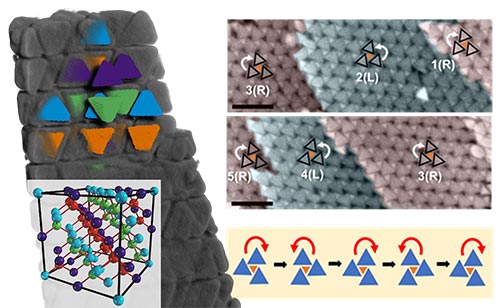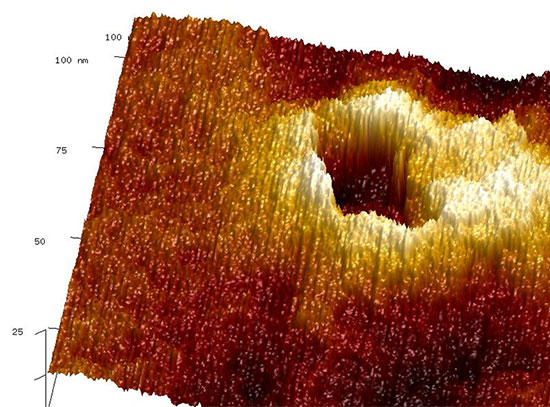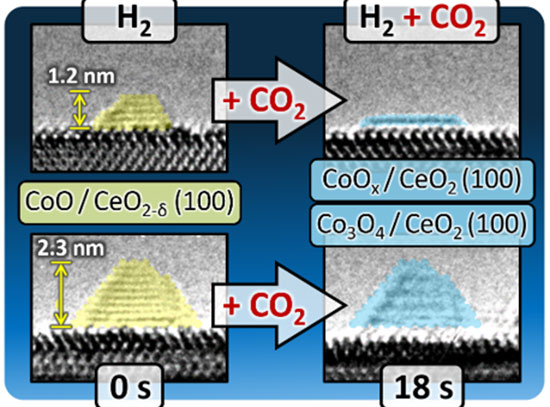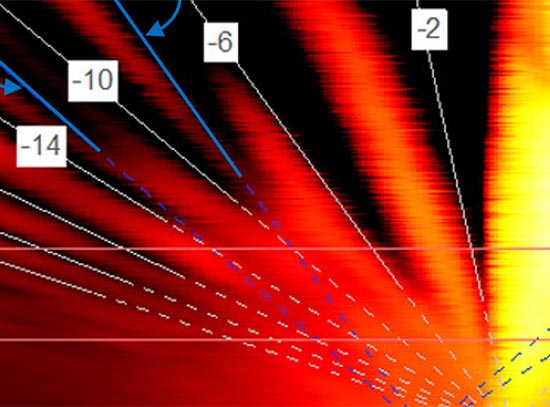Octo-diamond Crystal of Nanoscale Tetrahedra Unlock Interchanging Chirality
July 22, 2025
 enlarge
enlarge
3D assembly of stacked TH multi-bilayers with interchanging chirality (left- and right-handedness) and STEM tomography reconstruction highlighting four different oriented THs.
Scientific Achievement
Researchers from CFN, University of Michigan, and Columbia University discovered a new low-density "octo-diamond" crystal structure assembled from nanoscale tetrahedra (TH) of gold, featuring chiral bilayers that give rise to surface chiroptical properties.
Significance and Impact
This work discovers a new low-density ordered structure formed by TH through a novel pathway, showing how shaped nanoparticles can self-assemble into complex structures with new strategies for controlling chirality and optical behavior in nanomaterials.
Research Details
Researchers from CFN, University of Michigan, and Columbia University discovered a new low-density ‘octo-diamond’ structure formed by nanoscale solid tetrahedra with a 64-tetrahedron unit cell containing 8 cubic-diamond subcells. The formed crystal is achiral but is composed of chiral bilayers with alternating handedness. The left- and right-handed chirality of the bilayers, combined with the plasmonic nature of the gold tetrahedra, produces chiroptical responses at the crystal surface. The hydrophobic substrate facilitates the arrangement of tetrahedra into irregular ring-like patterns, creating a critical, uneven topography to stabilize the observed octo-diamond structure. This study reveals a potent way to affect colloidal crystallization through particle–substrate interactions, expanding the nanoparticle self-assembly toolbox.
- The octo-diamond structure contains 64 tetrahedra with 4 TH orientations per unit cell and includes 8 cubic-diamond sub cells arranged in alternating left- and right-handed chiral bilayers, revealed by Synchrotron-based X-ray tomography and electron tomography reconstructions.
- Hydrophobic substrates induced irregular ring-like particle arrangements that stabilized the unique crystal form, highlighting how particle-substrate interactions can guide novel colloidal crystallization pathways.
Publication Reference
F. Lu*, Y. Zhang, T. Dwyer, A. Michelson, T.C. Moore, H. Yan, K. Kisslinger, H. Zhang, X. Chen, S.C. Glotzer*, and O. Gang*, “Octo-diamond crystal of nanoscale tetrahedra with interchanging chiral motifs”, Nature Materials 24, 785 (2025).
DOI: https://doi.org/10.1038/s41563-025-02185-y
OSTI: https://www.osti.gov/pages/biblio/2555702
Acknowledgment of Support
This research used resources of the Center for Functional Nanomaterials and the Hard X-ray Nanoprobe Beamline (HXN) at 3-ID of the National Synchrotron Light Source II, which are part of the US Department of Energy (DOE), Office of Science Facilities, Brookhaven National Laboratory, under contract no. DE-SC0012704 (to F.L., Y.Z., A.M., H.Y., K.K., H.Z., X.C. and O.G.). This material is based on work supported by the US Army Research Office under grant no. W911NF-22-2-0111 (to T.D., T.C.M., S.C.G. and O.G.). T.D. also acknowledges support from the National Science Foundation Graduate Research Fellowship, grant no. DGE 1256260 (to T.D.). The computational modelling work used Bridges-2 at PSC through allocation DMR 140129 from the Advanced Cyberinfrastructure Coordination Ecosystem: Services & Support (ACCESS) program, which is supported by National Science Foundation grant nos. 2138259, 2138286, 2138307, 2137603 and 2138296 (to T.D., T.C.M. and S.C.G.). We thank E. A. Stach for helping with the STEM experimental details.
2025-22679 | INT/EXT | Newsroom









